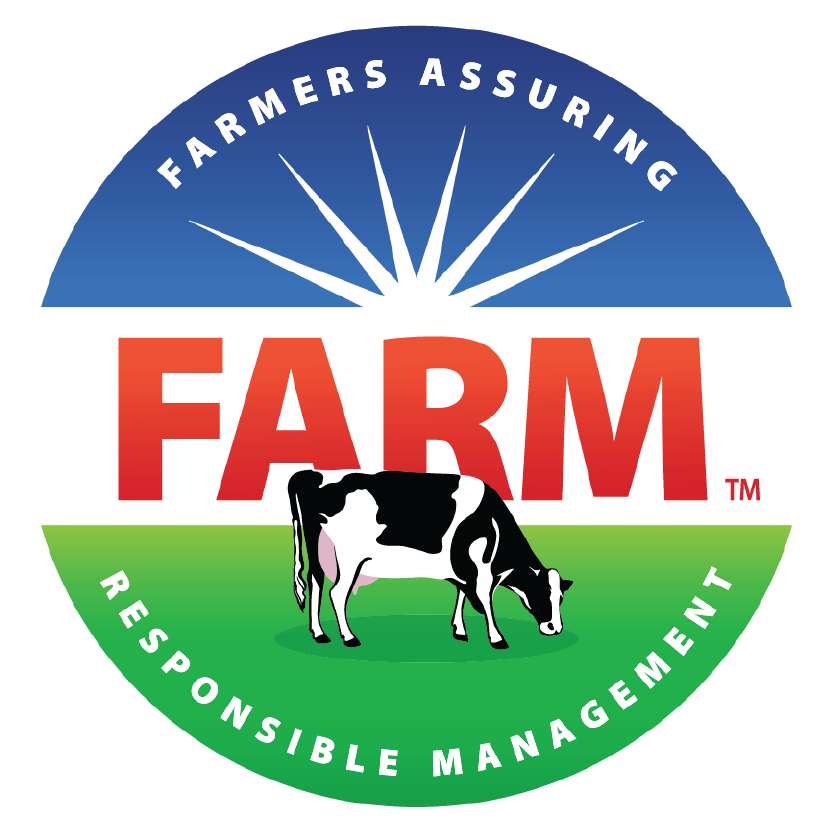Erosion Control: Grassed Waterways
alternative practice names:
Grassed Outlet
A grassed waterway is a shallow, graded channel designed to safely manage and direct surface water across farmland without causing soil erosion. By channeling runoff at a controlled, non-erosive velocity, grassed waterways minimize the risk of soil loss and gully formation.
Grassed waterways are typically shaped in parabolic or trapezoidal forms, allowing for efficient water flow while ensuring that farm equipment can cross the waterway without damaging either the channel or the machinery. The channel is typically planted with grass or other suitable vegetation. In areas with high water flow or velocity, stones or riprap may be installed along the center or sides of the waterway to further promote drainage and protect against erosion.
When used, in what regions in the U.S. is the practice found:
Upper Midwest, Northeast, Southeast
FARM SIZE
When used, typically found on farms of the following sizes:
All Sizes

Practice Benefits
Reduced soil erosion: Soil erosion reduces the quantity and quality of soil ecosystems and arable land. A grassed waterway will help control erosion, prevent gullies, allow access to fields, and retain soil in the fields. This will improve soil health and increase the farm's productivity.
Requirement for other best management practices: Grassed waterways support other practices such as diversions or cropland terraces.
We're always eager to update the website with the latest research, implementation insights, financial case studies, and emerging practices. Use the link above to share your insights.

Implementation Insights
Site-specific or Farm-specific requirements

Field size and slope: Any field with a watershed large enough to create a concentrated flow path across it is suited to installing a grassed waterway.
Local precipitation: Grass waterways are established in areas where precipitation causes runoff and erosion.
Required Capital Expenditures (CapEx)

Filling gullies: If the site has existing gullies, they will need to be filled and stabilized before installing the waterway. This may require additional capital for heavy equipment, such as excavators or bulldozers, to properly fill, grade, and shape the land. Soil or other fill material may also need to be transported to the site, which could add to the costs.
Grading and shaping: Proper grading and shaping of the waterway are essential to ensure effective water flow and prevent erosion. This process typically requires the use of machinery like bulldozers or motor graders to create a stable and functional slope.
Vegetation or stone installation: Once the waterway is shaped, it needs protection to prevent erosion until vegetation establishes or, if necessary, permanent stabilization with stone. Grassed waterways are generally successful on slopes not exceeding 15% and design velocities within the channel under 5 feet per second. Otherwise, a lined waterway practice should be considered.
Channel protection: Depending on the site's characteristics, additional measures to protect the channel may be required. Netting or stabilization fabric may be used in place of stone.
Culverts and drainage: In some cases, culverts or additional drainage structures may be necessary to manage water flow into or out of the waterway.
Required Operational Expenditures (OpEx)

Maintenance: Regular maintenance is essential to ensure the long-term functionality of grassed or stone waterways. This includes periodic mowing or controlled grazing to manage vegetation and prevent overgrowth. Fertilization may be necessary to maintain healthy vegetative cover, especially in areas with high erosion potential. Additionally, sediment removal from the waterway is important to preserve its capacity and prevent blockages that could undermine its effectiveness.
Damage repair: Heavy equipment use can damage the waterway, creating ruts that increase water velocity and erosion risk. This damage must be addressed promptly to prevent the waterway from becoming ineffective. Minimizing equipment traffic and avoiding herbicide overspray can reduce the likelihood of damage. When damage occurs, repairing the vegetation quickly is crucial to maintaining the waterway's integrity and preventing further erosion or sediment displacement.
Implementation Considerations

Soil type: Certain soil types, especially sandy or highly-erodible soils, can be challenging for establishing and maintaining grassed waterways. Stabilizing the waterway until vegetation is established can be more difficult in these areas.
Financial Considerations and Revenue Streams
FEDERAL COST-SHARE PROGRAM
Funding is available for this practice through USDA's Natural Resources Conservation Service (NRCS) Environmental Quality Incentives Program (EQIP) and the Conservation Stewardship Program (CSP).
Related EQIP Practice Standard: Grassed waterway (412).
Related CSP Enhancement: Enhance a grass waterway (E412A).
Notes:
Check with the local NRCS office on payment rates and practice requirements relevant to your location.
FEDERAL CONSERVATION FUNDING
Funding is available for this practice through USDA's Farm Service Agency (FSA) Conservation Reserve Program (CRP).
Related CRP Practice Standard: Grassed waterway (CP8A).
Notes:
Check with the local FSA office regarding CRP signup periods and conservation pactice requirements.
CRP provides 10-15 year rental payments, cost share for practice establishment and additional incentives.
Additional Resources

Environmental Impacts
IMPROVES WATER QUALITY
Grassed waterways reduce concentrated soil erosion and improve the water quality of downstream water bodies by trapping sediment and nutrients carried by runoff water. The broad and shallow shape of a grassed waterway allows water to flow through as a wide, shallow sheet; the slow, steady flow reduces erosion and keeps sediment from entering nearby downstream water bodies.
MAY SUPPORT BIODIVERSITY
Depending on the vegetation chosen, grassed waterways can improve biodiversity and act as refuges for beneficial organisms (Fiener and Auerswald 2003).
Contents
We're always eager to update the website with the latest research, implementation insights, financial case studies, and emerging practices. Use the link above to share your insights.

Alignment with FARM Program
FARM Environmental Stewardship (ES) V2-V3 Alignment
The optional FARM ES Conservation Practice Questionnaire (CPQ) asks about conservation practices implemented, including grassed waterways.
A grassed waterway is a shallow, graded channel designed to safely manage and direct surface water across farmland without causing soil erosion. By channeling runoff at a controlled, non-erosive velocity, grassed waterways minimize the risk of soil loss and gully formation.
Grassed waterways are typically shaped in parabolic or trapezoidal forms, allowing for efficient water flow while ensuring that farm equipment can cross the waterway without damaging either the channel or the machinery. The channel is typically planted with grass or other suitable vegetation. In areas with high water flow or velocity, stones or riprap may be installed along the center or sides of the waterway to further promote drainage and protect against erosion.
Practices and technologies
Erosion Control: Grassed Waterways
alternative practice name:
Grassed Outlet
REGIONALITY
When used, in what regions in the U.S. is the practice found:
Upper Midwest, Northeast, Southeast
COMPARABLE FARM SIZE
When used, typically found on farms of the following sizes:
0 - 100 cows, 100 - 500 cows, 500 - 2500 cows, 2500 - 5000 cows, Over 5000 cows

Practice Benefits
Reduced soil erosion: Soil erosion reduces the quantity and quality of soil ecosystems and arable land. A grassed waterway will help control erosion, prevent gullies, allow access to fields, and retain soil in the fields. This will improve soil health and increase the farm's productivity.
Requirement for other best management practices: Grassed waterways support other practices such as diversions or cropland terraces.

Implementation Insights
Site-specific or Farm-specific requirements

Field size and slope: Any field with a watershed large enough to create a concentrated flow path across it is suited to installing a grassed waterway.
Local precipitation: Grass waterways are established in areas where precipitation causes runoff and erosion.
Required Capital Expenditures (CapEx)

Filling gullies: If the site has existing gullies, they will need to be filled and stabilized before installing the waterway. This may require additional capital for heavy equipment, such as excavators or bulldozers, to properly fill, grade, and shape the land. Soil or other fill material may also need to be transported to the site, which could add to the costs.
Grading and shaping: Proper grading and shaping of the waterway are essential to ensure effective water flow and prevent erosion. This process typically requires the use of machinery like bulldozers or motor graders to create a stable and functional slope.
Vegetation or stone installation: Once the waterway is shaped, it needs protection to prevent erosion until vegetation establishes or, if necessary, permanent stabilization with stone. Grassed waterways are generally successful on slopes not exceeding 15% and design velocities within the channel under 5 feet per second. Otherwise, a lined waterway practice should be considered.
Channel protection: Depending on the site's characteristics, additional measures to protect the channel may be required. Netting or stabilization fabric may be used in place of stone.
Culverts and drainage: In some cases, culverts or additional drainage structures may be necessary to manage water flow into or out of the waterway.
Required Operational Expenditures (OpEx)

Maintenance: Regular maintenance is essential to ensure the long-term functionality of grassed or stone waterways. This includes periodic mowing or controlled grazing to manage vegetation and prevent overgrowth. Fertilization may be necessary to maintain healthy vegetative cover, especially in areas with high erosion potential. Additionally, sediment removal from the waterway is important to preserve its capacity and prevent blockages that could undermine its effectiveness.
Damage repair: Heavy equipment use can damage the waterway, creating ruts that increase water velocity and erosion risk. This damage must be addressed promptly to prevent the waterway from becoming ineffective. Minimizing equipment traffic and avoiding herbicide overspray can reduce the likelihood of damage. When damage occurs, repairing the vegetation quickly is crucial to maintaining the waterway's integrity and preventing further erosion or sediment displacement.
Implementation Considerations

Soil type: Certain soil types, especially sandy or highly-erodible soils, can be challenging for establishing and maintaining grassed waterways. Stabilizing the waterway until vegetation is established can be more difficult in these areas.
Financial Considerations and Revenue Streams
FEDERAL COST-SHARE PROGRAM
Funding is available for this practice through USDA's Natural Resources Conservation Service (NRCS) Environmental Quality Incentives Program (EQIP) and the Conservation Stewardship Program (CSP).
Related EQIP Practice Standard: Grassed waterway (412).
Related CSP Enhancement: Enhance a grass waterway (E412A).
Notes:
Check with the local NRCS office on payment rates and practice requirements relevant to your location.
FEDERAL CONSERVATION FUNDING
Funding is available for this practice through USDA's Farm Service Agency (FSA) Conservation Reserve Program (CRP).
Related CRP Practice Standard: Grassed waterway (CP8A).
Notes:
Check with the local FSA office regarding CRP signup periods and conservation pactice requirements.
CRP provides 10-15 year rental payments, cost share for practice establishment and additional incentives.
Additional Resources

Research
REFerences
IMPROVES WATER QUALITY
Grassed waterways reduce concentrated soil erosion and improve the water quality of downstream water bodies by trapping sediment and nutrients carried by runoff water. The broad and shallow shape of a grassed waterway allows water to flow through as a wide, shallow sheet; the slow, steady flow reduces erosion and keeps sediment from entering nearby downstream water bodies.
MAY SUPPORT BIODIVERSITY
Depending on the vegetation chosen, grassed waterways can improve biodiversity and act as refuges for beneficial organisms (Fiener and Auerswald 2003).

Alignment with FARM Program
FARM Environmental Stewardship (ES) V2-V3 Alignment
The optional FARM ES Conservation Practice Questionnaire (CPQ) asks about conservation practices implemented, including grassed waterways.






















